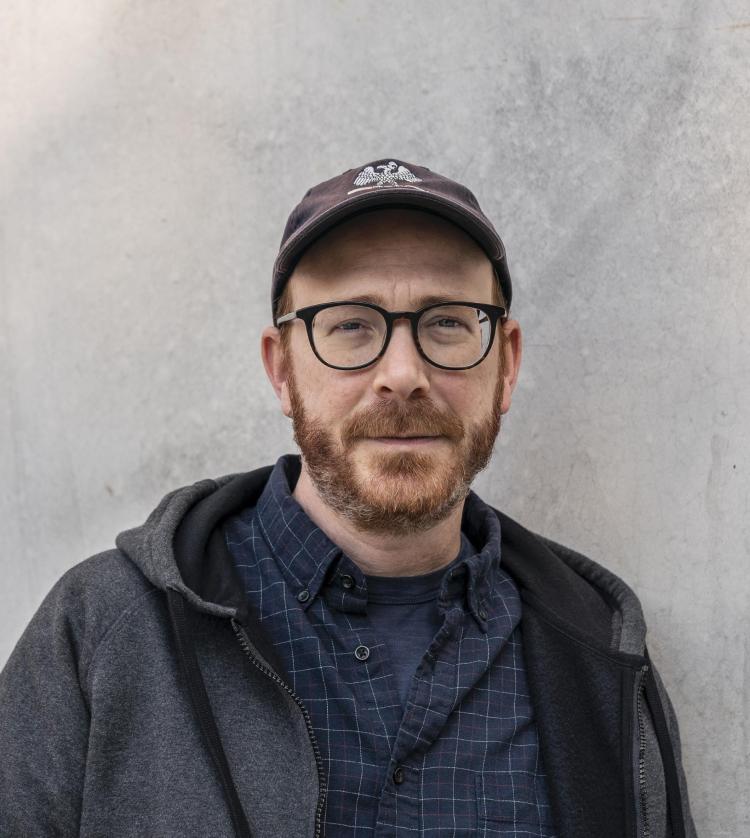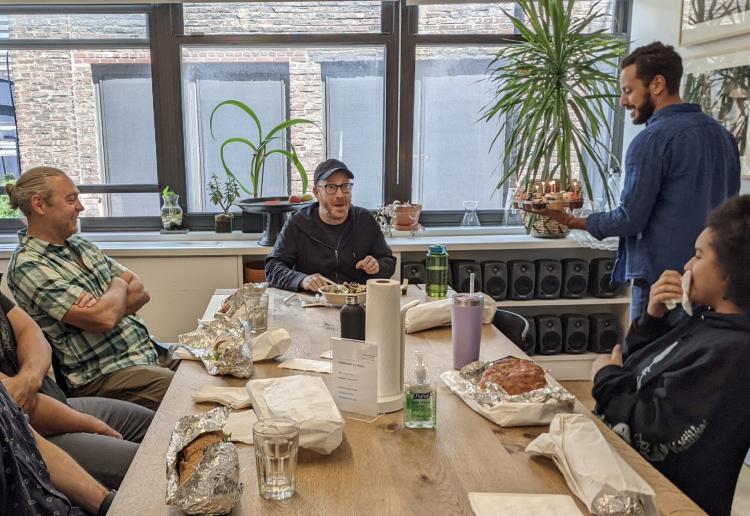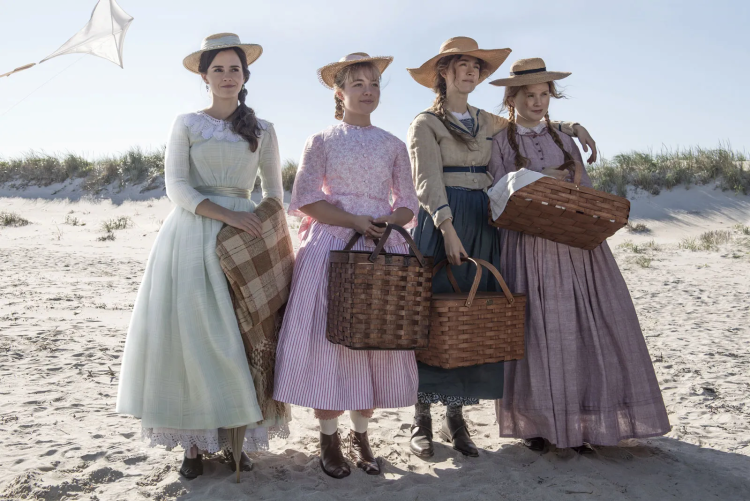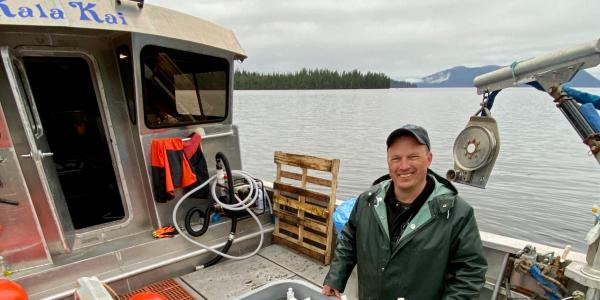CU cinema alum Nick Houy discusses his work editing the megahit Barbie and the joys of storytelling
Nick Houy thought about robbing the Chinese restaurant in Boulder where he worked.
He never would have done it, of course, but that’s the joy of storytelling: Exploring your most out-there ideas, asking “What if?” and making all your friends perform the script you wrote.
It was a heist movie called The Grand, and Houy and his friends screened it in the gym for their classmates at New Vista High School one day at lunch. They thought nobody would come, but everybody came “and it was really fun,” Houy recalls. “We all ate lunch and watched this movie I’d shot on S-VHS and Super 8. I remember thinking, ‘The sound in here isn’t great, it doesn’t look great,’ but people seemed to enjoy it anyway.”
The funny thing is, he only wrote, directed and shot the film so he’d have something to edit. That was what he really loved, making sense and stories from hours of footage, shaping scatters of stars into constellations.

Nick Houy, a 2004 CU Boulder graduate in film production, is considered a likely Academy Award nominee for film editing for his work on Barbie.
Now, when the Academy Award nominees for best film editing are announced Tuesday, Houy is widely predicted to be one of them for his work editing Barbie.
For Houy, a 2004 University of Colorado Boulder graduate in the Department of Cinema Studies and Moving Image Arts, editing Barbie marked his third collaboration with director and screenwriter Greta Gerwig. He also edited Lady Bird and Little Women—and all were exciting artistic challenges in a career that he has steadily grown from that lunchtime screening of The Grand in his high school gym.
“I think of the editor very much as one of the authors of a movie,” Houy says, “like a co-writer or co-director. As an editor, you’re also making the movie. For me, I’ve always sought out the best footage I can edit. A long time ago I realized that you can do anything with any group of footage, and that’s very exciting.”
Bringing images together
Houy grew up in Colorado Springs, the child of two copy editors, so he’s always been familiar with the idea of making an artist’s work as clean as possible. His parents also were movie fans, and he remembers going to Poor Richard’s, a Colorado Springs institution and restaurant/bookstore hybrid with a tiny screening room that was the place for New Wave cinema.
When he was in third grade, Houy and his mom moved to Boulder—he attended Mapleton Elementary, and she worked for CU Boulder with an office in Old Main. When he started at New Vista High School, he played drums in a punk band with an ever-changing name and pursued his passion for photography, especially black and white photography. He began thinking about how found images and footage could coalesce into a film with the right editing.
He would rent a camera from community television in the Dairy Arts Center, then rent a room there with two tape decks on which he learned to meld photography and his love of watching films through the art of editing.
“I would get Super 8 cameras from yard sales, and I remember meeting old men in parking lots who would have a trunk full of Super 8s, and I’d buy them for like $20,” Houy says. “I’d shoot Super 8 film and get it processed at (now-closed Jones General Store and Camera) on the Hill.”
He shot movies of every genre—and they were mostly terrible, he recalls with a laugh, but he was doing it so he could have something to edit.
“The first time I started editing even Super 8 movies, I’d have to splice it and put it together. I was just like, ‘Yeah, this is what I want to do,’” he says. “Even if you’re doing something like making a video for someone, like for a wedding, just putting a few shots together and adding music, that’s really exciting.
“Then, if you just go a little further and say, ‘What can I do with found footage?’ So, I would just go shoot and would make totally random found footage things, which was really fun to do, even more than drawing or being in a band or just shooting stills. It was just more exciting.”

Nick Houy (center) and his colleagues having a working lunch while editing Barbie.
While he was still in high school, Houy took screenwriting and film production classes at CU Boulder, and concentrated in film production when he became a student there. He remembers rewatching Francois Truffaut’s The 400 Blows in a class taught by Ernesto Acevedo-Muñoz and feeling profoundly moved by not only the storytelling, but by how music and images and every other element of filmmaking can come together into something that resonates and lingers.
Persistence pays off
After graduating, Houy moved straight to New York City for the simple reason that he’d always wanted to live there. He had about $1,000 and crashed on a friend’s couch while he worked at a video store and, in his free time, went from one post-production house to the next, leaving his resume and asking whether they’d give him work doing, well, anything.
Finally, he got a job moving furniture at Post Works, a pre-eminent film post-production facility where he happened to meet a film colorist who hired him to be an assistant conforming editor. In that role, he took a low-resolution film edit and increased the resolution so it could be color-corrected.
That led to a position on Michael Moore’s film Sicko: “(The film's colorist, Ben Murray) was like, ‘Do you want to be my assistant conforming editor at night instead of making coffee?' We would be up all night working on the conform. I would sleep under the theater and never go home because I much preferred to be working on a big movie, and I really lucked out.
“The Post Factory in those days, everyone was working there. Michel Gondry was down the hall, the Coen brothers, Sam Mendes—anyone who was cutting in New York in the mid-2000s. I saw Spike Lee and Godfrey Reggio when I was in college, and I ran into both of them there. I said to them, ‘Hey, I saw you speak at CU Boulder.’ I literally talked to them about them talking at CU Boulder, which just shows, to students out there, go see those people when they talk, even if it’s on Zoom, because you might run into them.”
He bumped into editor Anne McCabe in a Post Factory hallway when she was working on Adventureland and mentioned how much he loved one of her previous films, You Can Count on Me. “And then I just kind of followed her around, saying, ‘Please can I be your assistant editor?’ for like a year,” Houy remembers.
She hired him to work on Top Five, starring Chris Rock, which Houy considers one of his biggest breaks. Another was his experience working as an apprentice editor on 2008’s The Lucky Ones with editor Naomi Geraghty.
It was while working on The Lucky Ones that he was told one day that he needed to go pick up a mini fridge from another cutting room and bring it to the cutting room where he was working at the time, because his colleagues didn’t want to trek to the kitchen constantly. While he was grabbing the fridge, he met another apprentice editor named Jennifer Lame (who edited Oppenheimer and is also considered an Academy Award frontrunner for film editing) and they hit it off, becoming good friends.
Lame ended up editing Frances Ha, starring Greta Gerwig and directed by Noah Baumbach, and she became Baumbach’s editor. When Gerwig wrote the script for Lady Bird, Lame recommended “her friend Nick” to edit the film, and a creative partnership was born.

An image from Greta Gerwig's 2019 Little Women, which Nick Houy edited. (Photo: Wilson Webb/2019 CTMG Inc.)
It was while partnering with Gerwig on Little Women that he realized he’d reached a point in his career of working on Movies with a capital M: “When we got the first round of dailies, the first shot was of a horse and carriage pulling up outside a house, and that’s when I was like, ‘Oh, this is a movie movie.’”
Movies that people love watching
Barbie saw him ascending to another level of his career—it was a comedy (which he’d never really worked with before), it had elaborate, choreographed dance sequences (which he’d never cut before) and had not only an enormous studio budget, but even more enormous expectations from fans worldwide.
“We knew we had one thing against us: Comedies just don’t do well at the box office these days,” Houy says. “That’s the ethos of the industry, so we already were worried. But I remember reading the script and almost crying. Only Greta and Noah can write scripts like that, so I knew we had it. So, then the challenge was just to make sure we did all of that justice—these big comedy moments and big emotional moments, and huge songs by huge artists.”
Although he could have, Houy never visited the Barbie sets in London or Los Angeles, preferring instead to “feel like I’m as close to the audience member as I can be at all times,” he says. “I want to experience the film like an audience member, and an audience member has never walked onto that set. I want to be as fresh as possible, so I’m cutting from a place of me as the audience member. I want to make a movie that I want to watch.”
The film finished shooting on July 21, 2022, and was released July 21, 2023, so factoring in that a film must be completed at least a month before its release, Houy and his colleagues had just 10 and a half months to complete the movie with visual effects, music and everything else.
“It was insane, but I’m very proud of that,” he says.
Houy currently is lending editing support on Bob Marley: One Love and taking a bit of a breath following the enormous hit that Barbie became. Reflecting on it, “I will always see things I wish we’d done differently,” Houy says.
“The old adage is you’re never done; you either run out of time or money or both. I always want to keep working to make a movie better, until we run out of money or time, so that when I watch it again, I can be really proud of it. I just want to make movies that people love watching.”
Top image: Warner Bros. Pictures
Did you enjoy this article? Subcribe to our newsletter. Passionate about cinema studies and moving image arts? Show your support.



